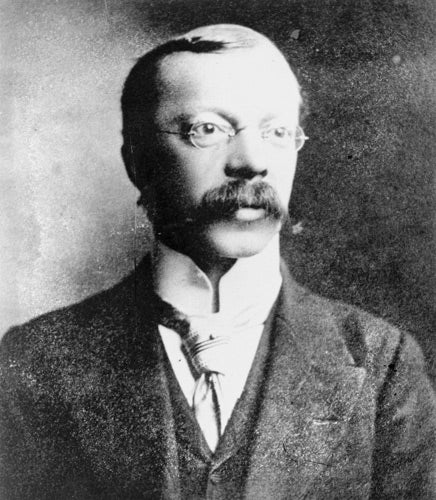Last Night's TV: It's hard to believe he was a lady killer
Was Dr Crippen Innocent? Revealed, Five; Duncan Bannatyne Takes On Big Tobacco, BBC

I think there's something going on. First, we learn that Valerie Singleton isn't a lesbian after all. Now, Five is telling us that Dr Crippen wasn't a murderer.
That doleful little man in Madame Tussauds, with the Kipling moustache and the wire-rimmed glasses, doesn't offer an epitome of the meek exterior concealing a murderous mind, he's actually looking so harmless and disconsolate because he didn't do it. What next? A special edition of Horizon throwing doubt on the theory that the world is round? I exaggerate a little, I grant you, but there was no question that it was a bit of a surprise to find that Revealed, a strand that I generally associate with uncovering the Catholic sympathies of popes, had actually come up with some real revelations in its Was Dr Crippen Innocent? documentary.
If Crippen was alive today, his case would have been handled very differently. Having whipped up an international media frenzy with the help of Marconi's new wireless after his escape across the Atlantic, Crippen would have retained Max Clifford to look after the media bids for exclusives and explore reality-television opportunities. He would then have used the cash to retain the best criminal lawyer available. As it was, the film suggested, poor Dr Crippen got railroaded, his barristers deprived of critical information that was available at the time of his trial (evidence that Cora had attempted to withdraw the couple's life savings shortly before her disappearance and that she had been using a local removals firm to take away her belongings). More gravely, Crippen didn't have access to information that would have made his conviction for Cora's murder utterly impossible, largely because most of the information didn't emerge until decades after his death.
The engine for Five's film – a human V8 called John Trestrail, who has made something of a hobby out of the Crippen case – started with a hunch based on his own experience as a leading toxicologist. Why, he asked himself, would a poisoner bury the fleshy parts of his victim in the cellar in his house when he'd successfully managed to dispose of all the really awkward chunks? And when he managed to test samples of what was found in Crippen's cellar, the mystery deepened further. Not only was it not Cora (if DNA tests using her living relatives were accurate), it wasn't even a woman. Since the remains were found wrapped up in Dr Crippen's pyjama tops, the only conclusion was that he'd bumped someone else off or that the investigating detective had done a little bit of evidential gardening, planting some helpful clues after three days of searches in the house had turned up nothing helpful. And perhaps the Crown had had a bit of help from its pathologist, Bernard Spilsbury, who confidently asserted that a scar on the remains matched Cora's medical record.
Whatever your views on the oddity of Crippen's behaviour at the time (he told friends and relatives that Cora had been taken ill and died in America and then legged it as soon as the police turned up), it was clear he wouldn't even have needed a particularly competent lawyer to walk free. As it was, it was just four weeks after the verdict was handed down that he was taking his last short walk in Pentonville prison. Roger Graef's film was a thoroughly enjoyable bit of forensic work, but the mind flinched a little from the thought of the hood rasping over the face of a man who still had no idea who was under the cobbles of his coal cellar.
Even if Crippen was a murderer, his death toll would have fallen far short of those pillars of the business community British American Tobacco, a company that likes to pretend that it is dealing in "lifestyle choice" and "pleasure", but is actually profitably engaged in selling a poison-delivery system. In Duncan Bannatyne Takes on Big Tobacco, the Dragons' Den regular travelled to Africa to find out what the company was up to in one of the few remaining growth markets. It was – surprise, surprise – up to no good, profiting, for instance, from "single-stick" sales of cigarettes (breaking packs down so poorer customers can buy one at a time), despite the fact that this is known to encourage purchases by underage smokers.
Bannatyne's film wasn't entirely satisfactory, since quite a lot of the evidence he found occupied that grey area into which tobacco companies have successfully been herded by various forms of health legislation. But he successfully conveyed the ugliness of the underlying enterprise. The World Health Organisation estimates that smoking accounts for 5.4 million deaths a year, more than tuberculosis, Aids and malaria combined. And while rich Westerners such as Bill Gates and Bill Clinton are attempting to reduce the fatalities caused by the latter three, British American Tobacco executives are working their socks off to increase sales and thereby the death toll from smoking. Bannatyne doorstepped BAT's annual shareholder meeting and secured this succinct disclaimer of ethical responsibility from one passing investor: "If they're stupid enough to smoke..."
Join our commenting forum
Join thought-provoking conversations, follow other Independent readers and see their replies
Comments